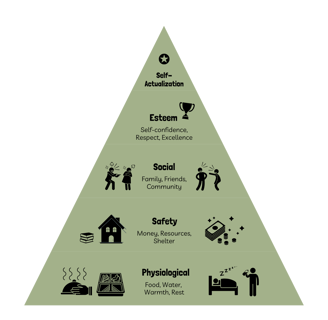What Is Maslow’s Hierarchy of Needs?
When life feels like it isn't heading in the right direction, we may ask ourselves:
What do I really need right now?
Maslow’s Hierarchy of Needs offers a simple but accessible way to answer that question. This psychological model helps us understand how different types of needs, where they be physical or emotional can shape our mental wellbeing and personal growth.
Maslow’s theory is commonly represented as a pyramid with five levels:
Physiological needs – food, water, sleep, shelter
Safety needs – security, routine, stability
Love and belonging – relationships, community, connection
Esteem – confidence, achievement, self-respect
Self-actualisation – creativity, personal fulfilment, purpose
It is suggested that we’re more likely to thrive when our foundational needs are met. And when they’re not, we often struggle in the categories that follow: emotionally, mentally, and even physically.
Why This Matters for Mental Wellbeing
1. Start with the Basics: Physiological and Safety Needs
When you’re feeling low, it’s easy to blame motivation or mindset. But Maslow reminds us:
You can’t focus on personal growth if your basic needs aren’t being met.
Are you getting enough sleep? Are you eating regularly and healthily? Do you feel safe or are you in danger?
People experiencing financial stress, housing insecurity, or burnout often find it difficult to focus beyond daily survival. Prioritising rest, routine, and physical stability is essential to wellbeing.
2. The Importance of Connection
As social beings, we need meaningful relationships. Whether it’s friends, family, support groups, or therapeutic connections—feeling seen, being heard and supported strengthens our emotional resilience.
When we feel isolated, it’s harder to manage stress. When we feel a sense of belonging, we heal better.
It can be a struggle to connect, but start small. Reach out to someone whose accepting and non-judgemental. Talk to someone on the phone or face to face.
3. Self-Esteem and Feeling Worthy
Once our social needs are met, the next step is feeling valued and confident. This doesn’t mean being perfect it means recognising your own worth.
Low self-esteem can make even small goals feel overwhelming. But building confidence is possible, especially with the right support. Therapy can help you challenge self-doubt and celebrate small wins.
4. Striving Toward Self-Actualisation
At the top of the pyramid is self-actualisation: becoming your full and truest self, the most authentic version of you.
This might look like:
Exploring creativity
Finding purpose in work or relationships
Setting and achieving personal goals
Self-actualisation is deeply personal and it’s not a final destination but an ongoing process. The more supported you feel in the lower levels, the more freedom you have to explore your potential. Getting the basics right is important.
How This Helps When Preparing for Therapy
Maslow’s Hierarchy can be a great tool for when preparing for therapy. It helps you reflect on where your needs are being met and where they aren’t.
Some reflective questions to ask yourself:
Am I meeting my basic needs?
Do I feel emotionally safe?
Am I connected to others?
How do I view myself right now?
These questions can shape the focus of therapy and help identify therapeutic goals and allow your therapist to support you more effectively.
Final Thoughts: A Path to Wellbeing
When things are becoming difficult use the hierarchy to explore where to work from. You may be neglecting your most basic needs and need to realign with this.
Meeting those needs one step at a time, can lead to long-term wellbeing and personal growth.


